9 Artistic Living Room Decor Ideas for Creative Homes
Want a living room that feels curated—not copy-pasted from a catalog? These nine ideas combine art, design, and a bit of play so your space looks intentional and richly layered. Each section includes what it is, how to do it, pro tips, and common mistakes to avoid. here are 9 Artistic Living Room Decor Ideas for Creative Homes.
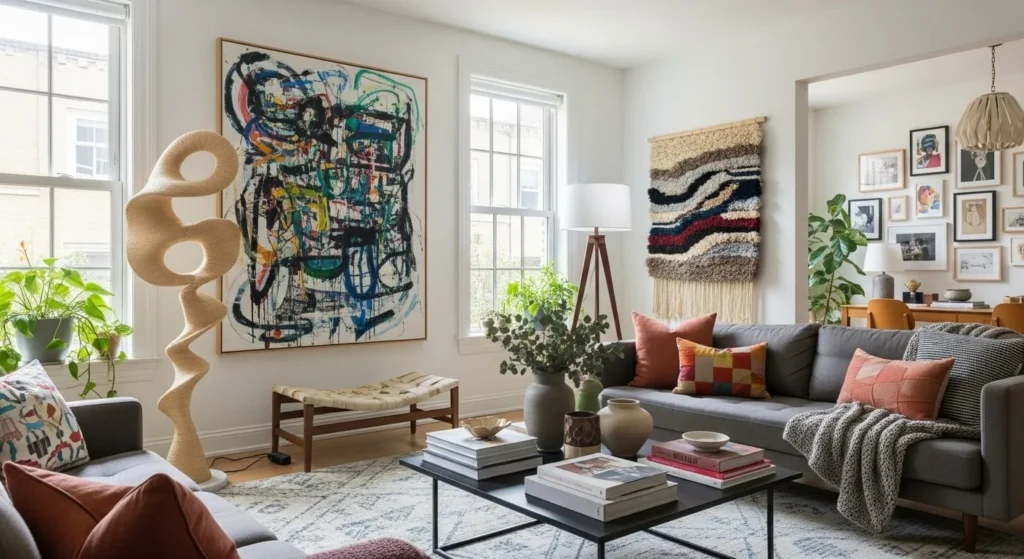
1) Curated Gallery Wall with a Narrative
What it is: A collection of framed pieces—prints, paintings, photos, textiles—that tell a cohesive story rather than a random mash-up.
How to do it
- Pick a theme: e.g., “Coastal grayscale,” “Family travel in warm tones,” or “Abstracts + line art.”
- Anchor first: Start with one medium-to-large piece at eye level (center ~57″ from floor).
- Map before nails: Arrange frames on the floor; snap a photo; adjust spacing (1.5″–3″ between frames).
- Mix frame profiles: Keep finish to 2–3 tones (black, natural oak, brass) for cohesion.
- Add dimension: Include a textile swatch, pressed botanical, or small sculptural shadow box.
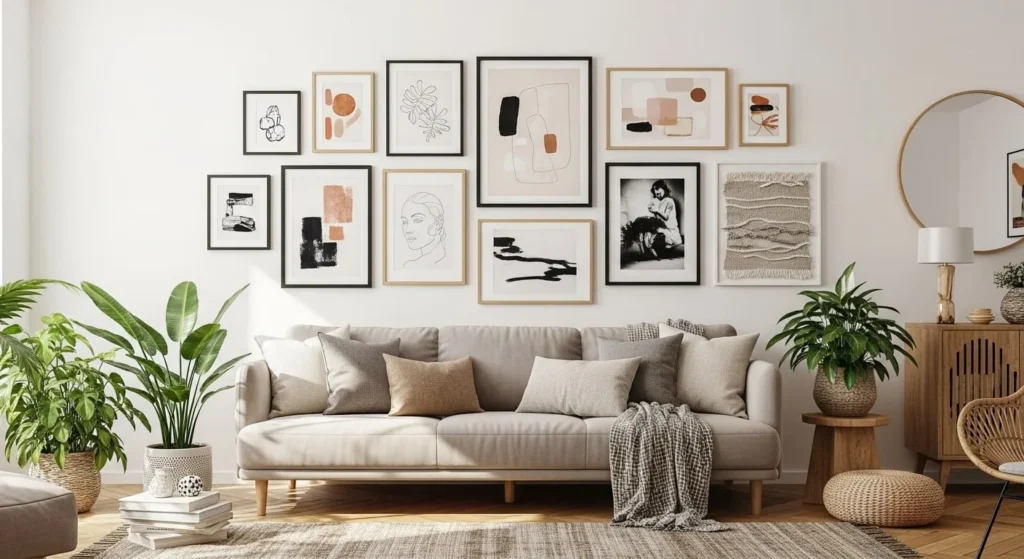
Pro tips
- For a sofa 84″ long, aim for a gallery width of ~60–70% of the sofa length.
- Use museum glass for one or two “hero” frames to cut glare.
Avoid
- Hanging too high, using only tiny pieces, or frames with wildly different finishes that fight each other.
2) One Oversized Statement Piece
What it is: A single large artwork (painting, photograph, textile) that sets the tone for the whole room.
How to do it
- Scale: Width ≈ 50–75% of the furniture beneath it (e.g., a 48–60″ piece above a 72–84″ sofa).
- Color strategy: Echo 2–3 colors from the art in pillows, vase, or rug for instant cohesion.
- Mounting: French cleats for stability; level line at ~57″ center height.
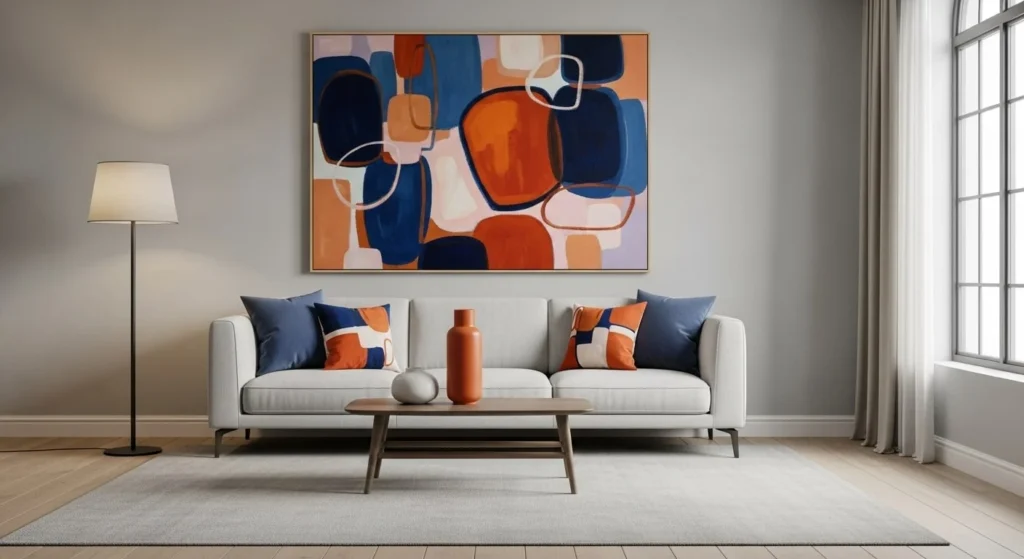
Pro tips
- If buying prints, upgrade to thick archival paper or canvas for presence.
- Consider diptychs/triptychs if doorways or elevators limit size.
Avoid
- Undersized art on a big wall; it looks like a placeholder.
3) Sculptural Lighting as Art
What it is: Statement lighting—floor lamps, pendants, or sconces—that doubles as sculpture.
How to do it
- Layer types: Ceiling ambient + a sculptural floor lamp + picture lights or sconces.
- Play with shape: Arcs, branching arms, pleated shades, glass orbs, origami forms.
- Dim-to-warm bulbs: 2700–3000K for living spaces; add dimmers.
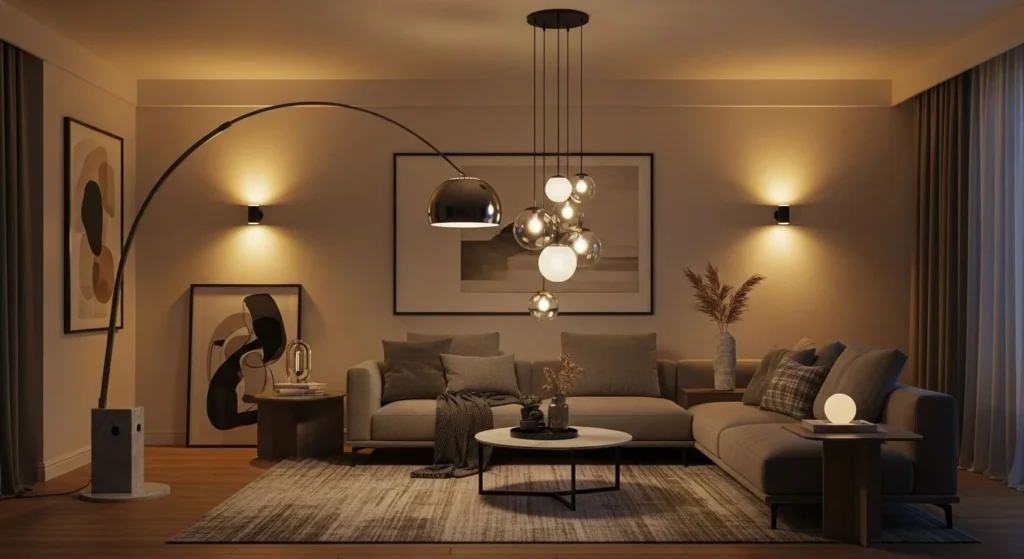
Pro tips
- Place a sculptural floor lamp where it’s visible from entry for a dramatic first impression.
- Use asymmetric pairs (e.g., a tall floor lamp on one side of the sofa, a low table lamp on the other).
Avoid
- All fixtures from the same set—mix silhouettes and materials.
4) Fiber & Textile Art for Texture
What it is: Woven wall hangings, macramé, kilim fragments, quilt squares, framed fabric, or tufted “art rugs.”
How to do it
- Choose one star texture: Oversized weaving above the sofa, or a framed vintage textile in the entry sightline.
- Mount well: Use a natural dowel or floating frame; keep a slim shadow gap from the wall.
- Balance with sleek: Pair nubby textiles with clean-lined furniture to avoid “boho overload.”
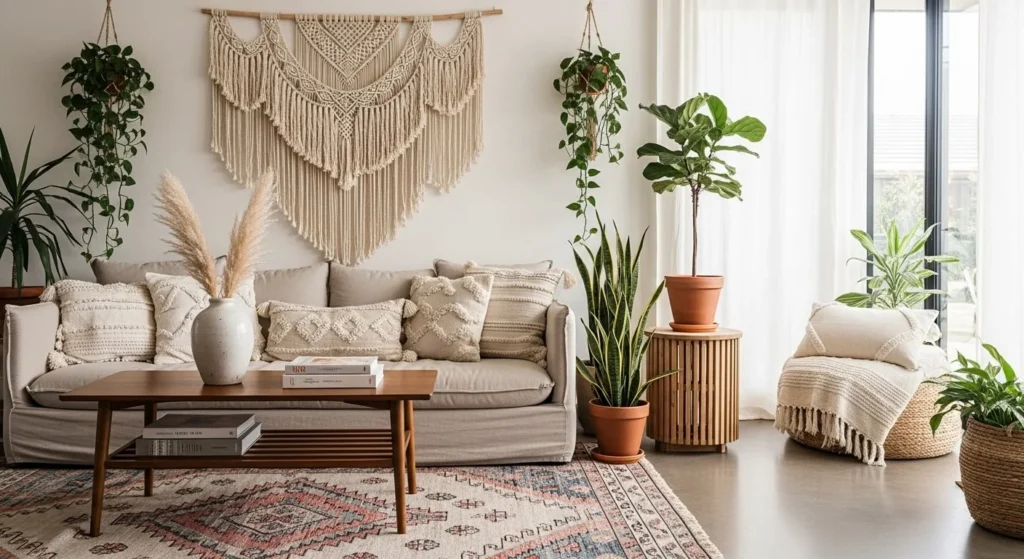
Pro tips
- Try a neutral palette with complex texture (ecru, oat, mushroom) to keep it sophisticated.
- Ensure textiles don’t compete with a heavily patterned rug—choose one to lead.
Avoid
- Too many small fiber pieces scattered around; cluster for impact.
5) Artful Shelving & Vignettes (Ceramics, Books, Objects)
What it is: Styled shelves that showcase ceramics, small sculptures, art books, and found objects like stones or driftwood.
How to do it
- Rhythm: Alternate vertical stacks, horizontal stacks, and negative space.
- Rule of thirds: Group in 3s and vary heights (tall vase + medium book stack + small object).
- Surface variety: Mix matte ceramic, glossy glaze, raw wood, metal.

Pro tips
- Face art books forward on small stands for a gallery-shop vibe.
- Use picture lights or LED strips under shelves to highlight forms.
Avoid
- Jamming every shelf full. Leave 20–30% breathing room.
6) Murals, Artist Wallpaper & Painted Shapes
What it is: Hand-painted murals, geometric color blocks, or fine-art wallpaper to give walls depth and personality.
How to do it
- Pick one wall: Usually the sofa wall or the main sightline.
- Scale matters: Large forms feel intentional; small shapes can look accidental.
- Prep right: For murals, sketch with painter’s tape; test swatches in daylight and at night.
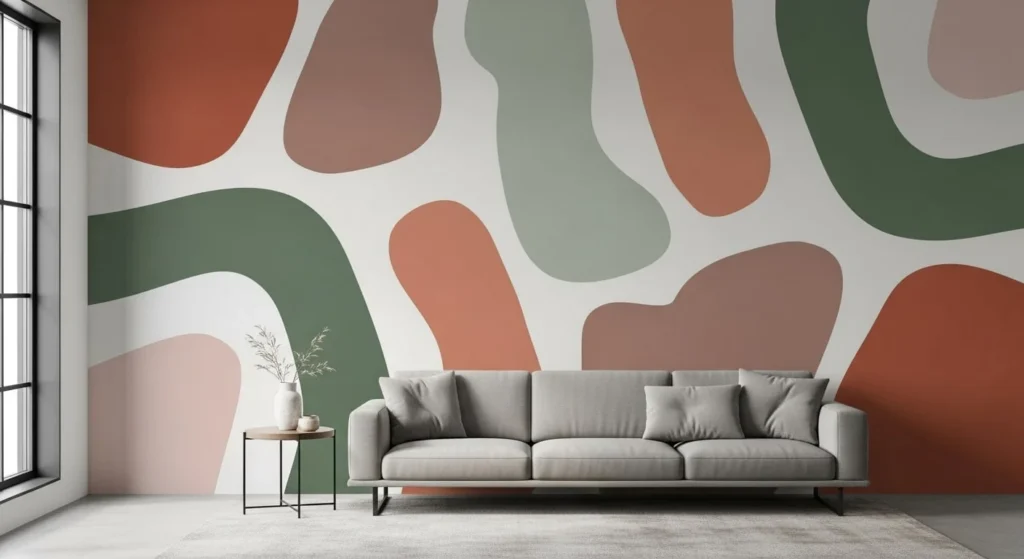
Pro tips
- A tone-on-tone arch or half-wall color block can fake architectural interest.
- Peel-and-stick murals are renter-friendly and easier to swap seasonally.
Avoid
- Busy mural + busy rug + busy pillows. Keep adjacent elements calmer.
7) Functional Art Furniture
What it is: Pieces that are both furniture and sculpture—think live-edge console, irregular resin coffee table, curvy accent chair, or a lacquered pedestal.
How to do it
- Pick one hero: Let one sculptural piece lead; keep others quieter.
- Mind ergonomics: Artistic chairs still need proper seat height (~17–18″) and back support.
- Contrast: Organic coffee table + rectilinear sofa; or angular bookcase + round ottoman.
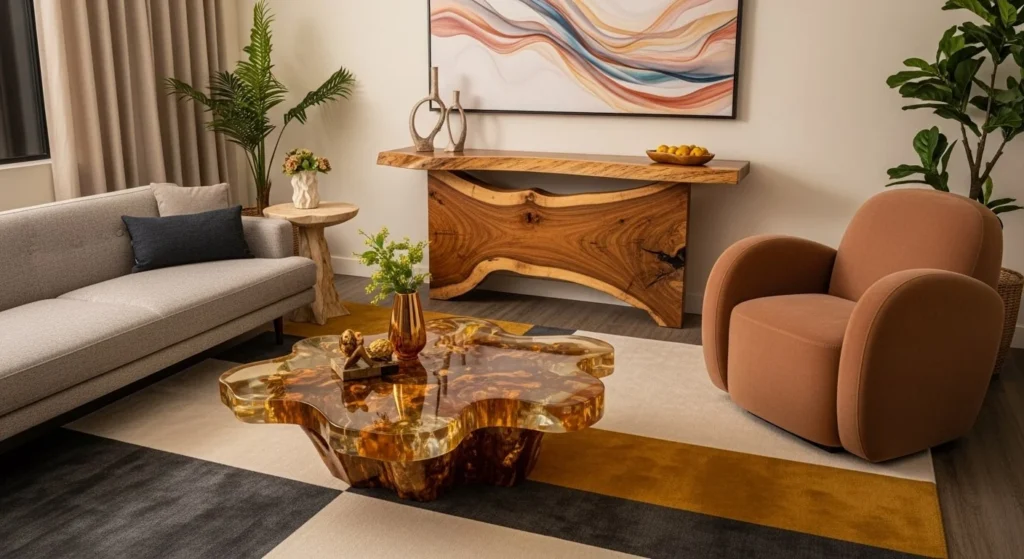
Pro tips
- Put sculptural pieces on a simple rug to define the “gallery” area.
- Pedestals with a single ceramic elevate small art to focal status.
Avoid
- A room full of “look at me” pieces—visual fatigue is real.
8) Mixed-Media Coffee Table Tableau
What it is: A rotating art composition on your coffee table: books, stones, candles, a miniature sculpture, a shallow tray.
How to do it
- Low + medium + one vertical: e.g., tray (low), book stack (medium), small sculpture or ikebana stem (vertical).
- Material mix: Glass + wood + metal or stone.
- Edit monthly: Rotate objects seasonally to keep it fresh.
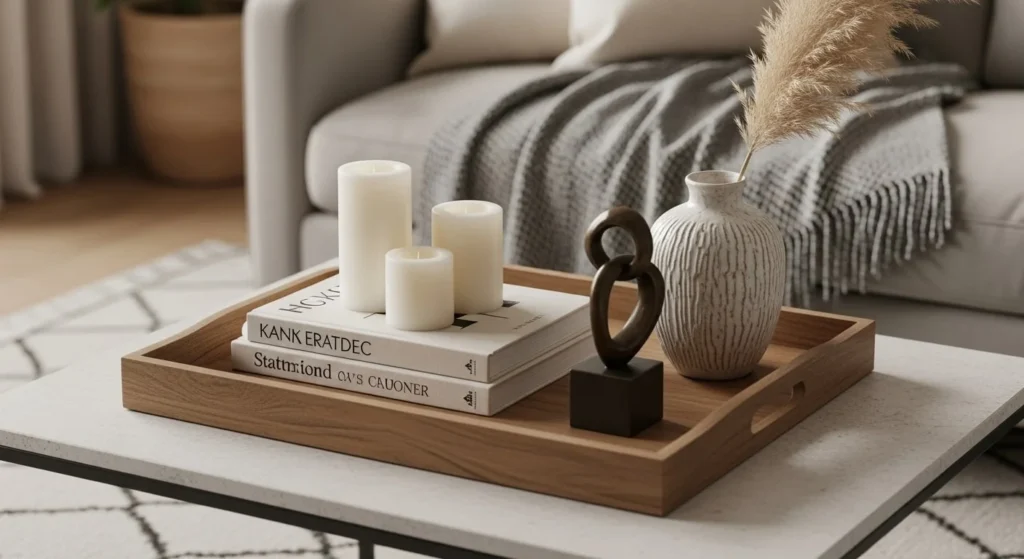
Pro tips
- Use a tray to corral items and leave 1/3 of the table clear for function.
- Add a single bold color accent that echoes your wall art.
Avoid
- Tiny knickknacks without presence. Aim for fewer, larger objects.
9) Digital, Kinetic & Light Art
What it is: Digital frames, projection art, LED light sculptures, mobiles—art that moves or changes.
How to do it
- Choose the vibe: Gentle gradient light piece for calm rooms; bold animated art for modern spaces.
- Placement: Avoid directly opposite windows to reduce glare; hide cords with paintable cable channels.
- Curation: Load a small, intentional playlist of works (no more than 10–15 to prevent visual noise).
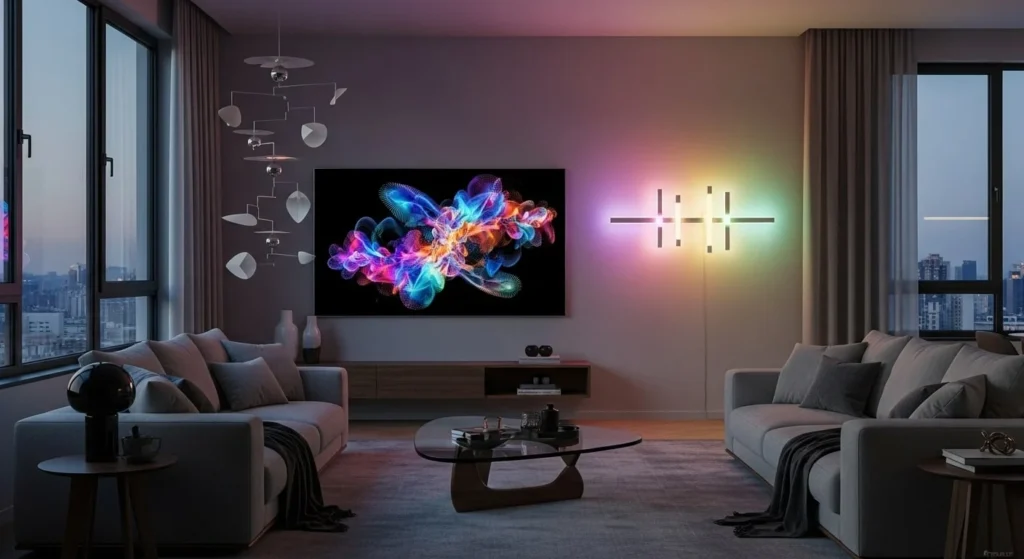
Pro tips
- Set digital frames to slow transitions with long dwell times (2–10 min) to feel like real art.
- For rentals, use command strips for light bars or small LED panels.
Avoid
- Overly bright, fast-moving loops in relaxation zones.
Color & Material Playbook (Quick Reference)
- Three-hue harmony: 1 main neutral (60%) + 1 secondary color (30%) + 1 accent (10%).
- Texture stack: Smooth (glass/metal) + medium (painted wood) + high (bouclé, wool, clay).
- Metals: Mix no more than two (e.g., brass + blackened steel). Repeat each at least twice.
Layout & Scale Cheatsheet
- Art centerline: ~57″ from floor (gallery standard).
- Above sofa: bottom of frame 6–10″ above the back cushion.
- Rug sizing: at least front legs of major seating on the rug; typical living rooms look balanced with 8×10′ or 9×12′.
- Sightlines: place key art where you see it first from the entry.
Budget-Savvy Ways to Source Art
- Emerging artists: Local art school shows, open studios.
- Limited editions: Small-run prints or photography.
- DIY but elevated: Frame fabric yardage, architectural drawings, or your own monochrome canvases with high-quality canvas and a float frame.
- Thrift & vintage: Look for good frames and re-mat; swap in your art.
Styling Toolkit
- Picture-hanging kit with hooks, D-rings, and French cleats
- Painter’s tape, laser level, spackle
- Museum putty for shelf objects
- Dimmers and warm LED bulbs (2700–3000K)
- Neutral linen or cotton mats (2–3″) to make small art feel important
Mini Roadmaps (Pick One to Start This Weekend)
A. The Statement Start (2–3 hours)
- Choose one large artwork.
- Color-match two accents (pillows + vase).
- Add a sculptural lamp.
—Done.
B. The Gallery Build (Half day)
- Curate 7–9 pieces around one theme.
- Map layout on floor; measure and mark.
- Hang with consistent spacing and one picture light.
—Done.
C. Textural Refresh (1–2 hours)
- Install a woven wall hanging.
- Restyle shelves with 3 ceramic forms and an art book.
- Create a mixed-media coffee table tableau.
—Done.
Final Thought
Artistic living rooms aren’t about owning expensive pieces—they’re about intentional choices: scale that suits your walls, textures you can feel, lighting that flatters, and a clear narrative. Start with one idea above, do it well, and let your space evolve like a lived-in gallery.







